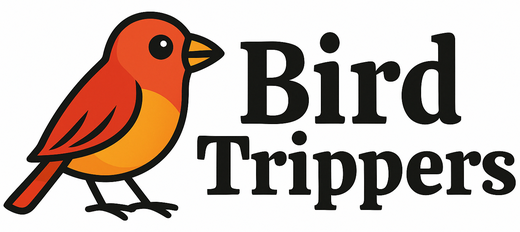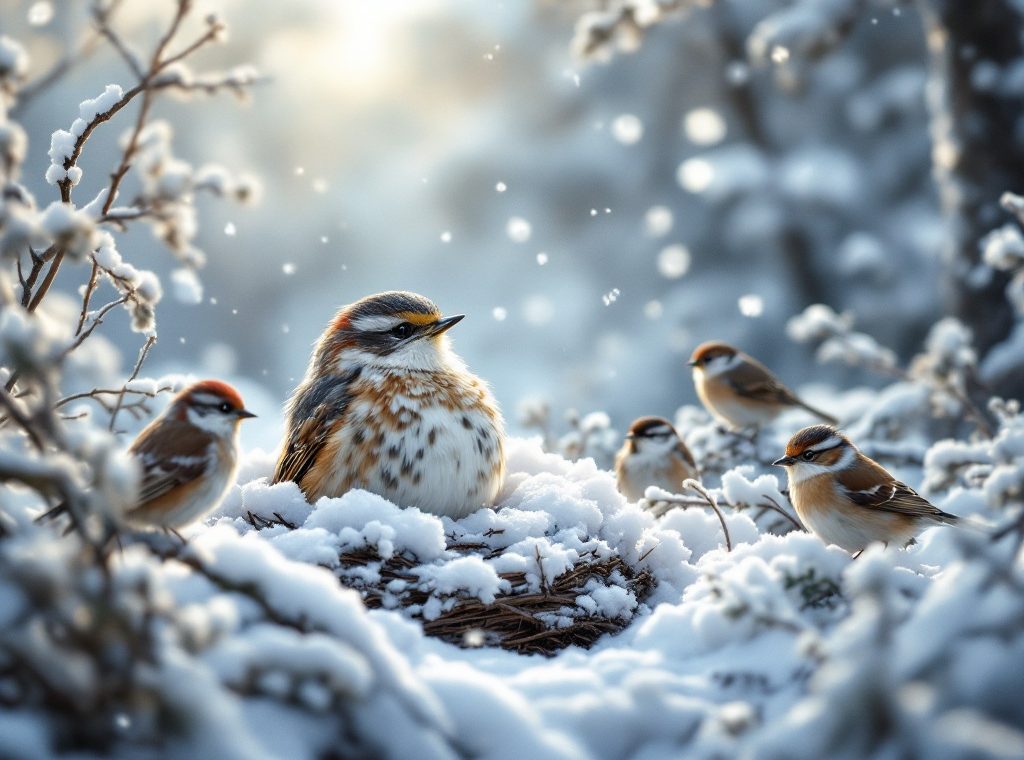Do Birds Hibernate: Life of a Bird in the Winter
Dive into the fascinating world of avian winter survival! Discover how most birds migrate or use short-term torpor to endure the cold, while the remarkable common poorwill is the only species known to truly hibernate. Explore the clever tactics birds employ, from fluffing feathers for insulation to adapting their diets, and learn how you can help them thrive during the harsh winter months. Uncover the secrets of bird survival and become a part of their winter story. Read on to learn more!
Important information

- The common poorwill is the only bird species known to truly hibernate.
- Other birds utilize torpor, a short-term state of reduced metabolism, to conserve energy during cold nights or food shortages.
- Many bird species migrate to warmer climates for the winter to find food and escape harsh weather.
- Non-migratory birds adapt to winter by changing their diets, fluffing their feathers for insulation, and seeking shelter.
- You can help birds survive winter by providing high-energy foods like suet and seeds, a source of unfrozen water, and shelter such as birdhouses or dense shrubs.
Do Birds Hibernate: Understanding Bird Behavior in Winter
Unlike most animals that hibernate, birds typically fly south for the winter, a journey known as migration. Some birds employ a survival tactic called torpor. However, the common poorwill stands out as the only bird species that truly hibernates.
What Is Hibernation in Birds?
Similar to mammals, some birds can enter a state of hibernation, slowing their metabolism and reducing their body temperature. The common poorwill stands out as the only bird species known to undergo true hibernation, a remarkable adaptation for surviving challenging environments.
Common Poorwill: The True Hibernator
The Common Poorwill (Phalaenoptilus nuttallii) stands out in the avian world: it’s the only bird species known to hibernate. This remarkable adaptation allows it to endure harsh winters with scarce food by dramatically lowering its metabolic rate and body temperature, sometimes plummeting to a mere 5°C. This energy-conserving strategy can sustain the poorwill for months at a time.
Hibernation vs. Torpor: Key Differences
Torpor is a short-term energy-saving state for birds when food is scarce. Hibernation, in contrast, is a much longer dormant period. The common poorwill, unusually for a bird, exhibits this extended dormancy.
How Do Birds Survive Winter Without Hibernating?
Birds display incredible resilience in the face of winter’s challenges. Some species undertake long migrations to warmer climates where food is plentiful. Others remain in their habitats and adapt their diets to include winter foods such as seeds, berries, and insects. To conserve energy during freezing nights, some birds even enter a state of torpor. Fluffing their feathers creates an insulating layer that traps warm air close to their bodies. These remarkable adaptations are essential for surviving the harshest winter conditions.
Winter Strategies and Survival Tactics
Fluffing feathers for insulation. Non-migratory birds fluff their feathers to create insulating air pockets that trap warmth, similar to a down jacket.
Entering torpor to conserve energy. These birds can enter a state of torpor, much like hibernation, which drastically reduces their energy consumption.
Adapting their diet. Their diet shifts towards seeds and berries, providing essential fuel during winter.
Huddling for warmth and protection. Many species huddle together in communal roosts for shared warmth and protection from the elements.
The Role of Torpor in Energy Conservation
Birds employ a clever strategy called torpor to survive chilly nights and food shortages. This short-term state allows them to conserve precious energy by lowering their body temperature and slowing their metabolism. They rely on stored fat reserves until conditions improve and they can forage again. This remarkable adaptation is used by hummingbirds, swifts, and nightjars, helping them endure challenging environmental conditions.
Temperature Regulation: Fluffing Feathers for Insulation
Birds fluff their feathers to trap warm air, much like a down jacket. This insulation helps them maintain a stable body temperature, which is crucial for survival, especially in freezing conditions.
Maintaining Energy Balance: Diet and Metabolism
To survive the harsh winter, birds become masters of energy management. Their adaptations involve dietary shifts and metabolic changes. They increase their food intake, focusing on energy-rich options like seeds, nuts, and fruit. Simultaneously, their bodies become incredibly efficient at processing these resources, extracting maximum energy from every morsel. This metabolic shift is key to enduring the challenging conditions winter presents.
Alternative Winter Survival Strategies in Birds
Many birds migrate south during winter to escape the cold and find food. Traveling in flocks offers several advantages, such as increased safety, improved foraging, and warmth during communal roosting. This is especially beneficial for birds like starlings, sparrows, and crows. The scarcity of insects in winter forces birds to adapt their diets. Many switch to seeds, berries, and nuts, while others, like woodpeckers, search for insects under tree bark. This adaptability is essential for their survival.
Migration: Fleeing Cold Weather for Warmer Climates
Birds migrate to survive harsh winter conditions and food scarcity. Seeking warmer climates with abundant food sources, they replenish their energy reserves, crucial for both survival and breeding. The Arctic Tern’s incredible 44,000-mile annual journey, from the Arctic to the Antarctic, exemplifies this impressive feat.
Flocking Behavior and Communal Roosting
Birds employ clever tactics to survive harsh winters. These include flocking and communal roosting, providing crucial warmth and protection. Flocking allows birds to share body heat, a vital advantage in freezing temperatures. Communal roosting offers safety in numbers, making them less vulnerable to predators. The increased vigilance of many eyes also helps detect danger quickly, boosting the group’s survival odds.
Adaptation to Seasonal Changes: Dietary Adjustments
As the seasons change, so do the diets of birds. Winter’s scarcity forces them to adapt, as insects vanish and birds transition to calorie-rich foods like seeds, berries, and nuts. These foods become crucial for survival, providing essential energy against the cold. For example, birds that primarily eat insects during warmer months often switch to berries and seeds in winter, demonstrating a remarkable adaptation to fluctuating food sources.
Essential Needs for Non-Migratory Birds in Winter
Winter’s scarcity of berries, seeds, and nuts creates significant survival challenges for non-migratory birds. Snow and frozen ground obscure these vital food sources. Fortunately, high-energy suet provides essential nutrients, helping these birds endure harsh winter conditions.
Beyond food, shelter is crucial for survival. Non-migratory birds need refuge from life-threatening wind, snow, and rain. Tree cavities and dense shrubs offer excellent natural protection. Birdhouses also provide safe havens, conserving energy and helping birds maintain body temperature. Evergreens offer consistent shelter throughout the entire winter season.
Reliable Food Sources: Overcoming Food Scarcity
Non-migratory birds face food scarcity during winter, employing ingenious survival strategies to combat the cold and hunger. They utilize several key tactics to increase their survival odds:
Caching Food
many birds store food, caching favorites like acorns and seeds in hidden locations to ensure a steady supply during lean times.
Dietary Adaptation
some species demonstrate remarkable dietary flexibility, switching from insects to berries or other readily available food sources as the seasons change.
Locating sheltered microhabitats is also crucial for survival. These sheltered locations, such as dense shrubs or areas near water, offer vital protection from harsh weather and often provide access to essential resources like food and water, ultimately increasing their chances of surviving the harsh winter months.
Shelter: Finding Adequate Protection in Cold Weather
Birds seek refuge to escape the harsh realities of winter, like snow, freezing rain, and powerful winds. Natural shelters, such as tree cavities, dense evergreens, and rocky crevices, offer excellent protection from the elements and predators. Sometimes, these natural havens are insufficient. Birdhouses provide a crucial alternative, offering birds a safe, supplementary space to rest and conserve energy.
How to Support Birds During Winter
Provide high-energy foods. Offer suet, peanuts, and black oil sunflower seeds to provide essential energy for winter survival.
Cater to finches with nyjer seeds. Offer nyjer seeds in a tube feeder specifically designed for finches.
Use a platform feeder for variety. Accommodate larger birds and offer a variety of food types on a platform feeder.
Ensure access to fresh water. Provide a consistent source of fresh water, especially crucial during winter.
A heated bird bath is ideal, but regularly replenishing a standard bath with warm water is also effective.
Create shelter options. Offer shelter from the cold and predators with birdhouses or dense evergreen shrubs.
Providing High-Calorie Foods and Bird Feeders
Birds require high-energy foods to withstand harsh winter conditions. Excellent choices include suet, peanuts, and sunflower seeds, which offer essential calories. Bird feeders provide a consistent food source, but different types attract various species.
Platform feeders accommodate larger birds.
Tube feeders attract smaller birds, such as finches, ensuring diverse bird nourishment.
Ensuring Water Availability
In winter, birds need access to unfrozen water for drinking and preening. A heated bird bath is a convenient way to provide this, ensuring they have a consistent supply.
A simpler alternative is to place a plastic ball in a larger water dish. This prevents the water from freezing solid. Regular refills are essential for the birds’ survival.
Creating Shelter: Birdhouses and Evergreen Shrubs
Birdhouses offer crucial protection from harsh weather and predators. Proper placement is essential: choose a spot sheltered from strong winds and direct sunlight.
Evergreen shrubs provide excellent camouflage, their dense foliage creating a natural barrier. A diverse mix of shrubs will further enhance the protective cover.


















